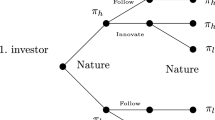Abstract
The threat of future entry affects the exploitation of common property resources in important ways. An incumbent has a strategic incentive to manipulate the resource stock to deter entry or to harvest more stock prior to entry rather than share the resource with the entrant. It is possible that the threat of potential entry can lead to the extinction of the resource even though actual competition would result in a steady state with a positive stock level.
Similar content being viewed by others
References
Berck, P. and J. Perloff (1984), 'An Open-Access Fishery with Rational Expectations', Econometrica 52, 489–506.
Bromley, D., ed. (1992), Making the Commons Work: Theory, Policy and Practice. San Francisco: Institute for Contemporary Studies.
Bulow, J., J. Geanakoplos and P. Klemperer (1985), 'Holding Idle Capacity to Deter Entry', Economic Journal 95, 178–182.
Carlos, A. and F. Lewis (1993), 'Depletion in the Lands of the Hudson's Bay Company, 1700-1770', Journal of Economic History 53.
Clark, C. (1973), 'Profit Maximization and the Extinction of Animal Species', Journal of Political Economy 81, 950–960.
Clark, C. (1980), 'Restricted Access to Common Property Fishery Resources: A Game Theoretic Analysis', in P.-T. Liu, ed., Dynamic Optimization and Mathematical Economics. New York: Plenum Press.
Clark, C., F. Clarke and G. Munro (1979), 'The Optimal Exploitation of Renewable Resource Stocks: Some Problems of Irreversible Investment', Econometrica 47, 25–47.
Clark, C. and G. Munro (1978), 'Renewable Resource Management and Extinction', Journal of Environmental Economics and Management 5, 198–205.
Clemhout, S. and H. Wan (1985), 'Cartelization Conserves Endangered Species?' in G. Feichtinger, ed., Optimal Control Theory and Economic Analysis 2. Amsterdam: North Holland Press.
Crabbe, P. and N. V. Long (1993), 'Entry Deterrence and Oberexploitation of the Fishery', Journal of Economic Dynamics and Control 17, 679–704.
Dockner, E., G. Feichtinger and A. Mehlmann (1989), 'Noncooperative Solutions for a Differential Game Model of Fishery', Journal of Economic Dynamics and Control 13, 1–26.
Dockner, E. and N. V. Long (1993), 'International Pollution Control: Cooperative Versus Noncooperative Strategies', Journal of Environmental Economics and Management 24, 13–29.
Fudenberg, D. and J. Tirole (1991), Game Theory. Cambridge: MIT Press.
Gilbert, R. J. (1989), 'Mobility Barriers and the Value of Incumbency', in R. Schmalensee and R. Willig, eds., Handbook of Industrial Organization, Volume 1. Amsterdam: North Holland Press.
Gilbert, R. J. and S. Goldman (1978), 'Potential Competition and the Monopoly Price of an Exhaustible Resource', Journal of Economic Theory 17, 319–331.
Gilbert, R. J. and D. Newbery (1982), 'Preemptive Patenting and the Persistence of Monopoly', American Economic Review 74, 514–526.
Gordon, H. S. (1954), 'The Economic Theory of a Common Property Resource', Journal of Political Economy 62, 124–142.
Johnston, R. and Libecap, G. (1980), 'Agency Costs and the Assignment of Property Rights: The Case of Southwestern Indian Reservations', Southern Economic Journal 47, 332–347.
Kamien, M. and N. Schwartz (1991), Dynamic Optimization: The Calculus of Variations and Optimal Control in Economics and Management. Amsterdam: North Holland Press.
Karp, L. (1992), 'Social Welfare in a Common Property Oligopoly', International Economic Review 33, 353–372.
Kemp, M. C. and N. V. Long (1980), 'Resource Extraction Under Conditions of Common Access', in M. C. Kemp and N. V. Long, eds., Exhaustible Resources, Optimality and Trade. Amsterdam: North-Holland Press.
Levhari, D. and L. J. Mirman (1980), 'The Great Fish-War: An Example Using the Cournot-Nash Solution', Bell Journal of Economics 11, 322–334.
Mason, C. F. and S. Polasky (1994), 'Entry Deterrence in the Commons', International Economic Review 35, 507–525.
Mason, C. F. and S. Polasky (1997), 'The Optimal Number of Firms in the Commons: A Dynamic Approach', Canadian Journal of Economics 30, 1143–1160.
McLean, J. (1849), Notes of Twenty-Five Year's Service in the Hudson's Bay Territory. London: Richard Bentley.
McMillan, J. and H.-W. Sinn (1980), 'Oligopolistic Extraction of a Common-Property Resource: Dynamic Equilibria', in M. C. Kemp and N. V. Long, eds., Exhaustible Resources, Optimality and Trade. Amsterdam: North-Holland.
Milgrom, P. and J. Roberts (1982), 'Limit Pricing and Entry under Incomplete Information: An Equilibrium Analysis', Econometrica 50, 443–459.
Naito, T. and S. Polasky (1997), Theory and Empirics of Fish Wars: The Case of the Berings Sea Donut Hole. Working paper, Oregon State University.
Negri, D. H. (1990), '“Strategy” of the Commons', Natural Resource Modeling 4, 521–537.
Ostrom, E. (1990), Governing the Commons: The Evolution of Institutions of Collective Action. Cambridge University Press.
Ostrom, E. (2000), 'Collective Actions and the Evolution of Social Norms', Journal of Economic Perspectives 14(3), 137–158.
Polasky, S. and O. Bin (2001), 'Entry Deterrence and Signaling in a Nonrenewable Resource Model', Journal of Environmental Economics and Management 42, 235–256.
Tsutsui, S. and K. Mino (1990), 'Nonlinear Strategies in Dynamic Duopolistic Competition with Sticky Prices', Journal of Economic Theory 52, 136–161.
Wiggins, S. and G. Libecap (1985), 'Oil Field Unitization: Contractual Failure in the Presence of Imperfect Information', American Economic Review 75, 368–385.
Author information
Authors and Affiliations
Rights and permissions
About this article
Cite this article
Mason, C.F., Polasky, S. Strategic Preemption in a Common Property Resource: A Continuous Time Approach. Environmental and Resource Economics 23, 255–278 (2002). https://doi.org/10.1023/A:1021288205689
Issue Date:
DOI: https://doi.org/10.1023/A:1021288205689




